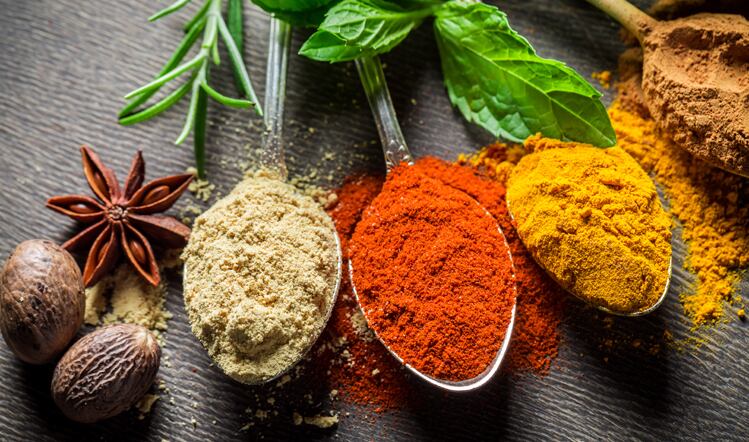Key points
- Ever more vibrant colours
- Are synthetic variants set to return?
- Colouring foods grow in popularity
- The rise of ever more exotic tastes
- Replicating the taste of spices without the challenges
- Natural and clean-label demand continues
- Investment shows market confidence
When it comes to colour and flavour considerations, food manufacturers want to have their unicorn cake and eat it.
Demand for natural colours and flavours has accelerated to the point where natural is no longer merely a trend, but an expectation among the vast majority of customers.
Yet, manufacturers are not prepared to compromise on sensory experience for the sake of a clean-label. ‘Say it with colour’ appears at number six on the list of Innova Market Insights’ top trends in the food industry for 2018, driven in part by the desire of millennials to Instagram their food and disseminate images among friends.
Research by restaurant chain Zizzi last year found that 18 to 35-year-olds spend five whole days a year browsing food images on Instagram – and a third of them would avoid restaurants with a weak Instagram presence.
Small wonder then, that food manufacturers are doing all they can to lift the visual appeal of their products.
Ever more vibrant colours (return to top)
Sugar reduction: how flavours can play their part

Next month, UK health agency Public Health England will report on progress towards a target to reduce sugar content across nine processed food categories by 20% by 2020.
Manufacturers have described the targets as challenging, but they are also providing an opportunity for brands to use flavours as a way of compensating for sugar reduction in food and drink.
Sensient Flavors says its Sweet Solutions Natural Flavourings can compensate for significant sugar reduction across a range of product categories, including beverages, thereby helping suppliers achieve a sugar content below the level at which April’s Soft Drinks Industry Levy will come into effect.
“Flavours are being used extensively to compensate for sugar reduction,” says Barbara Lezzer, director of marketing for Europe – Sweet and Beverage, at the company.
Sensient is not alone in spotting an opportunity from the sugar reduction agenda. Giants such as Cargill, with its Eversweet, and Tate & Lyle with its Dolcia Prima Allulose, are vying with food-tech start-ups such as DouxMatok to deliver the same perceived sweetness while reducing the need for added sugar.
With consumers increasingly demanding natural alternatives to sugar, those firms that can tick both the health and taste boxes will be well-placed to reap the rewards as the sugar reduction agenda gathers pace.
“In general, we see more and more manufacturers explicitly using colour to highlight products and attract attention,” says Guido de Jager, head of group marketing at GNT Group.
De Jager points to recent creations including unicorn and mermaid confectionery, galaxy-themed bakery products, deep purple ice cream and pink burger buns as examples of the phenomenon.
“Consumers love products with an eye-catching look, which they can share on social media,” he explains.
Whether it’s through conspicuous colours or striking sheens, ingredients manufacturers are responding in kind with applications that give products a spectacular appearance.
Horizon Specialities recently launched a range of natural pearlescent pigments to give a metallic lustre to all kinds of products.
The pigments are available in gold, silver, bronze and red and achieve the pearlescent look through a combination of mica, iron oxides and titanium dioxide.
The company says the pigments are ideal for confectionery, indulgent bakery products and desserts.
The test for manufacturers looking to bring new concepts to market is whether they can satisfy demand for vibrant colours while still ticking the natural box.
Are synthetic variants set to return? (return to top)
It is “unlikely” that there will be a switch back to synthetic colours, as there continues to be a global trend towards clear solutions, says James Smith, md at Kalsec.
The test, he believes, is to provide vibrant natural colours that are stable.
“Maintaining vibrancy of shade in a heat-processed application is the greatest challenge.
“Cost, stability and performance are key considerations when formulating to provide the desired hue with naturally-sourced colour,” Smith explains.
The challenge is in the offering, adds Thierry Gay, technical sales director of colours at Frutarom Natural Solutions.
“You have to play with limited source materials and at the same time try to develop new edible sources that are approved by regulation and are stable and allergenic free.”
Gay is also doubtful that challenges with creating vibrant colours from natural sources will result in a shift back to artificial colours.
He does, however, believe that where stable, natural solutions cannot currently be found “producers will have to compromise and either use artificial or a combination between artificial and natural”.
De Jager is more dismissive of the need to keep the synthetic option open.
“The times when producers had to choose between vibrant colour and naturalness are long gone. Colouring foods provide perfect brilliance and performance, so there is no need to step back to synthetics,” he says.
Colouring foods grow in popularity (return to top)
As part of the wider shift to natural, the use of colouring foods, as alluded to by de Jager, is a key industry trend.
Sensient Food Colors cites Mintel data showing that colouring foods accounted for 14% of new food and beverage launches in Europe in 2016, and the company believes they are a logical extension beyond natural colours.
Jacqui Passmore, marketing manager for UK & Ireland at Dawn Foods, agrees and notes that adding fruit juice and vegetable juice concentrates and extracts are another way of adding both flavour and colour without artificial additives.

Dawn offers several products such as compounds – all-natural flavoured concentrated pastes that can be added to frostings and filling creams – which can be used in this way, Passmore explains.
“All the compounds feature natural fruit juice concentrate, such as pomegranate, blueberry, mango or passionfruit, and add a subtle flavour and hue,” she adds.
Gay notes that categories such as dairy and beverages are now using fruit and vegetable concentrates on a regular basis.
On the other hand, de Jager points out that savoury products like soups, sauces and meat are often coloured with spices, which don’t provide sufficient colour control as their use is aligned to the taste.
The use of ‘natural’ additives like carmine or beta-carotene is also on the decline, he claims, as consumers become increasingly sceptical of the extensive use of chemicals or solvents to extract natural additives from materials like nettle and spinach.
For this reason, de Jager says “colouring foods are key to success in satisfying consumer expectations on visual appeal and naturalness”, adding that GNT’s Exberry colouring foods combine performance with naturalness.
The rise of ever more exotic tastes (return to top)
The fusion of naturalness with sensory excitement is also a key trend in flavours, according to Sensient Flavors, which has recently launched All Natural Flavour Collections across five key botanical areas: florals, herbs, spices, tea and ginger.
The company notes that food tourism is on the rise, which in turn exposes consumers to tastes of far-away countries, leading to an increased use of herbs, spices and exotic fruits and vegetables at home.
Not only do these allow for the individualisation and experimentation consumers crave, but they are also perceived as being healthy and “good for you”, which is another top driving factor for consumer purchase, the company adds.
Sensient Flavours identifies Asian inspiration as being an especially significant trend.

It says Japan in particular is at the forefront of global food innovation, and traditional Japanese flavours like cherry blossom and matcha are just as interesting to western markets as the out-of-the-ordinary flavours being used in the country’s latest product launches.
Sensient also claims to be seeing more and more category blurring, so it’s now not just about savoury flavours in sweet products, but also cocktails in ice cream, desserts in chocolate, and confectionery-inspired beverages as well.
The consumer quest for global flavour experiences continues to grow, concurs Kalsec business development manager Vince Martin.
“Manufacturers are responding with some sensational new products – and variations on existing products. African and Middle Eastern flavours in particular are being used to exciting effect,” he explains.
Replicating the taste of spices without the challenges (return to top)
Typical of African and Middle Eastern cuisine, Martin says, would be the mixing of peppers with warm, complementary spices such as cardamom and nutmeg – or black pepper and cumin.
“Bright flavours such as cilantro – the leaf of the coriander-seed plant – are often used alongside these.
Spicy elements are combined with other seasoning components to provide depth and breadth of flavour and tongue-feel,” he adds.
Consumer demand for strong aromas and interesting tastes has also resulted in a growing focus on finding flavour applications that replicate the taste of spices while removing some of the challenges surrounding their use, which include volatile prices and variable quality.
Mane has recently introduced a new range of flavours called Sense Capture Spices, which it claims enables manufacturers to reduce the use of spices by up to 50% in savoury applications such as black pepper, cumin and nutmeg.
The objective, according to the company, is not to substitute spices but to reduce some of the issues associated with their use by using a flavouring solution.
Looking ahead, de Jager highlights flavours that tend to sour, such as turmeric and kale, as ones to watch, while Passmore at Dawn reports that fresh flavours such as citrus or fruit are proving popular as an inclusion or topping on baked products.
In both cases, demand for natural and healthy products is a key driver.
Natural and clean-label demand continues (return to top)
The UK market, and UK retailers in particular, are at the forefront of the shift to clean-label and simplified ingredients declarations.
This has created significant commercial opportunities for ingredients manufacturers that have put natural offerings at the heart of their business model.

The race is on for food manufacturers to develop cleaner-label recipes, Martin at Kalsec claims.
“Consumers are driving the trend – they’re increasingly seeking out foods that don’t contain anything artificial,” he explains.
“The simpler the better. Make no mistake. That doesn’t mean they’re prepared to compromise on appearance, taste or shelf-life.”
“Companies are looking to be the first and this is a great way to differentiate their brands and products,” says Gay.
“Products can be positioned as free-from, or a cleaner label, more familiar ingredients or even a ‘coloured with’ statement. This is an opportunity to communicate an added value to the consumer.”
Such messages appeal to consumers who are increasingly concerned about their own health and wellbeing.
De Jager cites research by market research firm TNS that shows using a front-of-pack claim stating “coloured with fruit and vegetables” conveys positive product characteristics such as ‘is healthy’, ‘is safe’ or ‘is 100%’ that can increase brand preference.
Investment shows market confidence (return to top)
This, in turn, is giving manufacturers the confidence to invest in building their capability to produce clean-label food.
Founded in 2010, Bristol-headquartered Plant-Ex Ingredients spent its formative years building a foundation of people and resources from which to launch into the global marketplace.
Today, the £7m turnover company is looking to grow its presence in Europe and Asia following investment in a new development laboratory, which it says will allow a wider diversity of new flavours and applications to be developed.
Last month, it also opened a new spray-drying and powder-blending plant. The culmination of a £1.8m spend, the plant has three spray driers, and it enables Plant-Ex to blend powders in batches of up to 2,000kg, assuring batch consistency.
Colouring foodstuffs already comprise a large proportion of the portfolio supplied by the company, but to extend its offer in this area further, a new pasteurising plant is in the pipeline. The site will boost product shelf-life while providing Plant-Ex with greater transport capabilities.
Such investments are predicated on the belief that the trend for natural products will continue long into the future.
It feels like a safe assertion. Indeed, some businesses suggest the trend will move a step beyond health and wellbeing and begin to incorporate additional societal issues.
“We believe that in the future, responsible food choices that take health, sustainability and ethical considerations into account will become more important,” says de Jager.
“This means shoppers will not only look out for clean-labels but transparent supply chains.”
It’s yet another box that suppliers of colours and flavours will need to tick if they are to stay one step ahead of the competition.
The switch to natural: why challenges remain

Despite the preponderance of natural ingredients in western markets, it would be wrong to say that all of the technical barriers created by switching from synthetic to natural flavours and colours have been overcome.
“There are several technical challenges when it comes to switching from synthetic to natural, the main one being the stability issues due to varying effects of light,” says Benny Antony, joint md at Arjuna Natural Extracts.
“Also, you have to imitate the exact colours of the synthetic colours and it is a big challenge in some cases to find the exact shade.”
Jacqui Passmore, marketing manager UK & Ireland at Dawn Foods, highlights the challenges that still exist with “colour fade” over the shelf-life of a product.
She also explains that achieving red colours that are natural, vegetarian, and halal-suitable are still challenging in bakery products such as red velvet, which is currently on-trend across all bakery lines.
“Dawn is one of the few bakery suppliers to offer a red velvet mix using natural colours,” she points out.
Performance under different conditions
Using natural colour in a specific application requires detailed understanding of the way a natural product performs under different conditions, according to Sensient Food Colors.
An anthocyanin, for example, can provide a beautiful shade of red in a raspberry soft drink application, yet will not deliver the same results in a citric environment of a lemon soft drink due to differing stability properties, says the company.
Although most flavour types can now be recreated as natural, Sensient Flavors says the technical challenges are more apparent for named naturals where the product cannot be created as an extract, such as natural bubblegum flavouring, or in applications that require complex processing or heat treatment.
A lack of harmonisation in the regulation of natural applications between countries can also be a challenge, according to Thierry Gay, technical sales director of colours at Frutarom Natural Solutions, as can managing supply chain challenges such as cooling.
The fact the market is moving inexorably towards natural solutions means manufacturers will have to continue solving these issues if they want to grow their share of the market.
